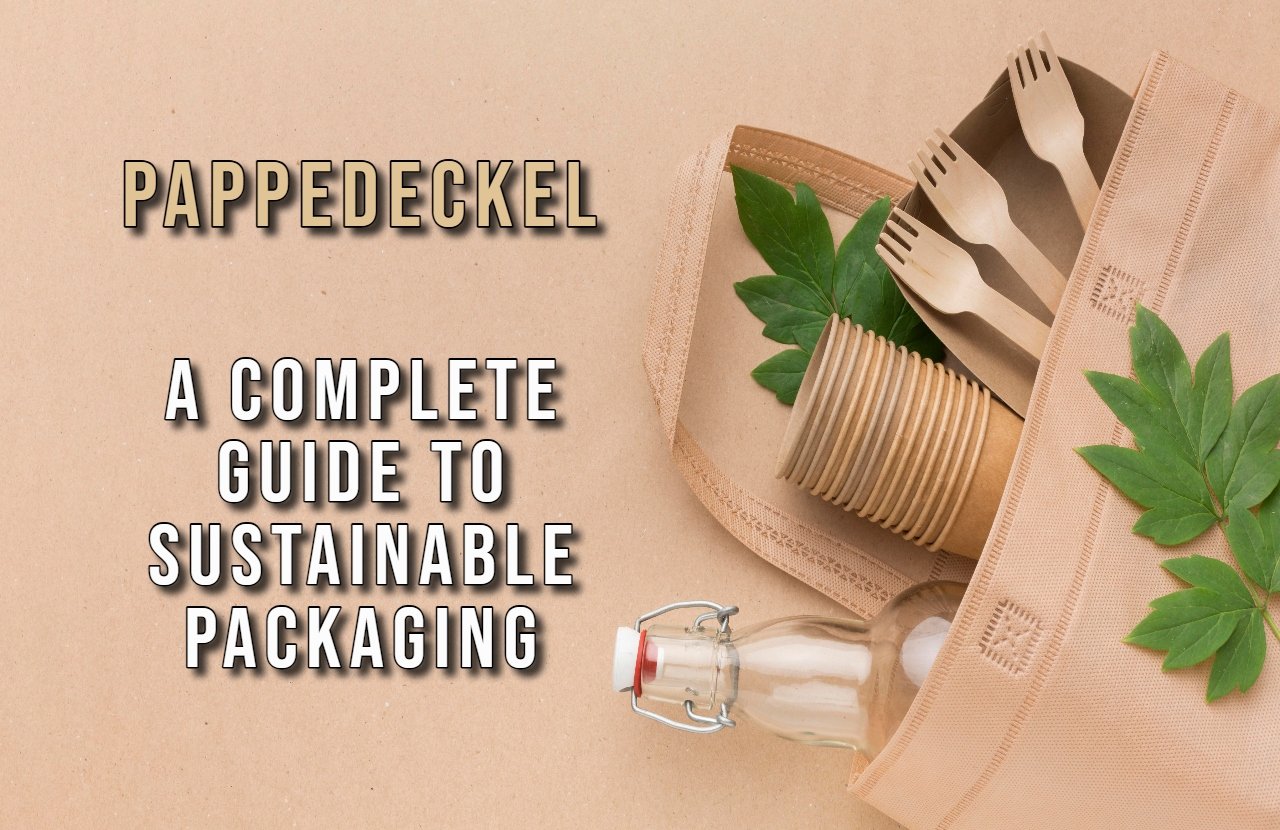In the age of growing environmental awareness, sustainable packaging is no longer just a trend but a necessity. Among the many innovative materials redefining packaging, pappedeckel has emerged as a practical, eco-friendly, and cost-effective solution. Derived from sturdy paperboard, it serves multiple functions, from protecting food to providing sustainable alternatives to plastic. Businesses, cafes, and even households increasingly favor it for its balance of functionality and ecological benefits.
This comprehensive guide will explore everything you need to know about pappedeckel, from its origins and design to its applications, advantages, and role in the global sustainability movement.
History of pappedeckel
The idea of using paper as a packaging material is centuries old. Cardboard was first introduced in the 19th century, revolutionizing transportation and product safety. Pappedeckel, meaning paper lid or cardboard lid, came as a response to rising demand for disposable yet environmentally safe packaging. Early iterations were simple and uncoated, but technological improvements have made them durable, water-resistant, and versatile, shaping them into a reliable choice for modern industries.
You Might Also Like: The Artistry of Ciulioneros
Meaning and origin of pappedeckel
The German word pappedeckel translates literally to “paperboard lid.” Over time, it has become an umbrella term for eco-packaging lids and covers used in food, beverages, and retail. More than a product name, it now symbolizes eco-conscious consumption and sustainable business practices.
Why pappedeckel matters in modern packaging
Plastic lids dominate the packaging market, but their environmental cost is enormous. Pappedeckel addresses this problem by offering:
- Biodegradability – Breaks down naturally without harming the environment.
- Renewable sourcing – Made from recyclable and renewable fibers.
- Affordability – Lower production costs compared to alternatives.
- Consumer appeal – Brands benefit from green marketing strategies.
As consumers demand greener products, businesses adopting pappedeckel gain both environmental and financial advantages.
Pappedeckel in the food and beverage industry
Perhaps the most common use of pappedeckel is in cafes and restaurants. Coffee cups, takeaway containers, and deli boxes now use sturdy paper lids. Unlike plastic, these lids are safe against heat, recyclable, and often customizable with branding. Fast-food chains and artisanal cafes alike favor them for balancing convenience with eco-responsibility.
Types of pappedeckel
Different designs exist to meet diverse industry needs:
- Flat lids – Ideal for containers, boxes, and trays.
- Domed lids – Suitable for beverages with extra toppings, such as lattes or whipped cream.
- Coated lids – Added resistance against moisture and grease.
- Uncoated lids – 100% biodegradable and compostable.
This variety ensures suitability across multiple applications.
Manufacturing process of pappedeckel
The making of pappedeckel combines traditional paper-making with modern technology:
- Raw material preparation – Recycled or virgin pulp is refined.
- Forming and pressing – Paperboard sheets are molded into lids.
- Drying – Moisture is removed for strength.
- Cutting and shaping – Precision tools create uniform lids.
- Coating (optional) – Adds resistance without compromising recyclability.
Sustainability measures, such as using renewable energy and recycled water, further reduce environmental impact.
Eco-friendly benefits of pappedeckel
The benefits extend beyond functionality:
- Reduces landfill waste.
- Lower carbon footprint compared to plastic.
- Can be composted in home or industrial composting systems.
- Encourages circular economy practices.
Adopting pappedeckel is more than a business decision—it is a step toward climate responsibility.
Durability and performance
Skeptics often assume that paper lids lack durability. However, modern innovations make pappedeckel heat-resistant, spill-proof, and capable of withstanding pressure. With protective coatings derived from natural resins, they resist moisture without compromising recyclability.
Design and customization of pappedeckel
Brands use packaging not only for functionality but also for marketing. Pappedeckel can be customized with:
- Company logos.
- Slogans or eco messages.
- Artistic patterns and seasonal designs.
This dual role of protection and brand visibility makes it a powerful marketing tool.
Pappedeckel in retail packaging
Beyond food, retail businesses embrace pappedeckel for boxes and product covers. Clothing brands, cosmetics companies, and electronics packaging all use paper lids to reduce plastic waste. This trend resonates with environmentally conscious shoppers who prefer eco-friendly packaging.
Cost and value comparison
Compared to plastic, pappedeckel may have slightly higher upfront production costs, especially when coatings are involved. However, the long-term benefits include:
- Lower waste management costs.
- Enhanced brand reputation.
- Compliance with green regulations.
For businesses, the return on investment outweighs the initial expense.
Pappedeckel for small businesses
Small enterprises often struggle to balance cost and sustainability. Affordable paperboard lids allow local cafes, bakeries, and street vendors to adopt eco-friendly packaging without major financial strain. This strengthens community branding and customer loyalty.
Global demand for pappedeckel
With rising bans on single-use plastics, global demand is skyrocketing. Europe and Asia lead the market, while North America rapidly follows suit. As more countries legislate against plastic waste, pappedeckel is set to become a packaging staple worldwide.
Comparing pappedeckel with plastic lids
| Feature | Pappedeckel | Plastic Lid |
| Eco-friendly | Biodegradable | Non-biodegradable |
| Heat resistance | High | High |
| Cost | Moderate | Low initially |
| Brand image | Positive eco perception | Negative consumer response |
This comparison highlights why businesses are shifting toward paper-based alternatives.
Challenges with pappedeckel adoption
Despite its many advantages, some challenges exist:
- Limited availability in some regions.
- Higher production costs compared to plastic.
- Performance concerns in extreme conditions (e.g., very hot liquids).
However, ongoing research is addressing these issues.
Innovations in pappedeckel
Recent innovations include:
- Waterproof coatings made from plants.
- Biodegradable inks for branding.
- Stronger multi-layer paperboard technology.
Such advancements make pappedeckel even more versatile and competitive against plastic.
Future of pappedeckel
The future looks bright as governments, businesses, and consumers align toward sustainability. Expect to see:
- Wider availability globally.
- Integration into e-commerce packaging.
- More creative and artistic designs.
- Potential smart features, like QR codes for recycling instructions.
Pappedeckel will likely play a central role in sustainable packaging revolutions.
Conclusion
Pappedeckel is more than a packaging material—it’s a symbol of conscious consumption, eco-responsibility, and innovation. From protecting your morning coffee to shaping global sustainability strategies, it proves that small changes can have a big impact. As the world moves away from plastics, pappedeckel stands as a practical, affordable, and environmentally friendly alternative that benefits both businesses and consumers.
FAQs
What is pappedeckel made of?
It is made from durable paperboard, often sourced from recycled fibers.
Is pappedeckel safe for hot drinks?
Yes, modern coatings make it heat-resistant and spill-proof.
Can pappedeckel be composted at home?
Uncoated versions are fully compostable, while coated ones may require industrial facilities.
Why is pappedeckel better than plastic lids?
It is biodegradable, recyclable, and supports eco-friendly business practices.
Does using pappedeckel increase business costs?
Slightly, but the benefits of customer loyalty and regulatory compliance outweigh expenses.
Where is pappedeckel most commonly used?
It is popular in cafes, restaurants, retail packaging, and e-commerce.

